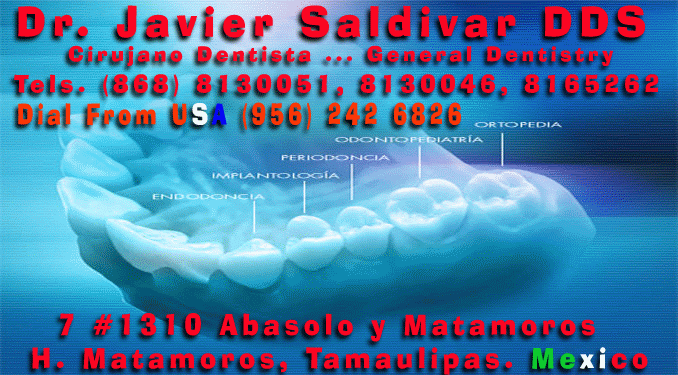
|
|
|
|
|
| Dolor dental. |
Enjuague vigorosamente su boca con agua tibia para desalojar restos de comida. Use hilo dental para remover cualquier resto de comida que pueda estar atrapado entre los dientes. Si existe inflamación, coloque compresas frías por fuera de su mejilla. No use calor, ni coloque aspirina en el diente adolorido ni en la encía. Acuda a nuestra consulta para que podamos realizar un diagnóstico y un tratamiento adecuado. |
| Diente que se desaloja por un golpe. |
Si el diente está sucio, límpielo suavemente bajo el agua corriente. No lo cepille, insértelo y fíjelo en su alvéolo. Si esto no es posible, coloque el diente en un recipiente con leche o agua fría, venga a vernos lo antes posible. No olvide traer el trozo de diente. Debemos asegurarnos de que estamos vacunados con la vacuna antitetánica. |
| Diente roto. |
Suavemente limpie el área afectada con agua tibia. Coloque compresas frías en la cara, en el área del diente lastimado para reducir la inflamación, si es posible rescate el trozo de diente. Acuda a nuestra consulta lo antes posible. |
| Objetos atrapados entre los dientes. |
Trate de remover el objeto con hilo dental, con cuidado para evitar dañar las encías. No trate de sacar el objeto con instrumentos cortantes o puntiagudos. |
| Fractura mandibular. |
Inmovilice la mandíbula con cualquier trapo (pañuelo, corbata, toalla). Si existe inflamación aplique compresas frías. Acuda al hospital. |
| Mordedura de lengua o labio. |
Aplique presión directamente sobre el área sangrante con una gasa estéril. Si existe inflamación, aplique compresas frías. |
| Problemas con aparatos de ortodoncia. |
Si un alambre está causando irritación, cubra la punta con una pequeña bola de algodón, cera de abeja, o un pedazo de gasa. |
| Luxación mandibular, imposibilidad de cerrar la boca. |
Guarde la calma, cuanto más relajado esté, más fácil regresará la mandíbula a su lugar. Acuda a nuestra consulta para que podamos reducir la luxación. Si no es posible visitarnos se deben realizar dos movimientos: primero traccionar la mandíbula hacia abajo y segundo empujarla hacia atrás. |
|

Regular dental care helps prevent inconvenient dental emergencies. However,
dental emergencies can and do occur. Listed here are some of the more common
dental emergencies and what you can do until you can get to our office. A good
rule of thumb: if it hurts, do NOT wait to make an appointment. We will be happy
to see you as soon as possible.
Toothache/Sensitive Teeth
A toothache or a sensitive tooth can be caused by several different types of
problems. At times it is a sign of a dying nerve inside the tooth. Over-the-counter
pain relief medication can temporarily relieve the pain. Contact us for an
appointment as soon as you notice the problem. Slight pain, if left untreated,
can progress into facial or oral swelling and severe pain. Commonly, tooth pain
can be eliminated with endodontic treatment (root canal therapy).
A sensitive tooth may be due to exposed root, a leaking or defective filling,
decay, a bite-related problem, or a dying nerve. See us as soon as possible for
an evaluation.
Broken Tooth
Teeth with large fillings can easily break or fracture. Call our dental
office as soon as possible to have the tooth evaluated and restored. If the
broken tooth is not treated, more serious problems can develop. Broken teeth may
or may not be sensitive to air and temperature changes. Sensitivity and pain are
not necessarily an indication of how badly the tooth is damaged.
Tooth Knocked Out
Place the tooth in water or a wet towel or cloth. Do not try to scrub or wash
the tooth. Get the tooth and the patient to us immediately. The faster the tooth
can be repositioned, the better the odds that the tooth can be saved. Time is
crucial.
Object Stuck Between Teeth
Use dental floss to gently remove the object. Do not use sharp or pointed
objects to push or pry the object from between your teeth. If the object does
not come out easily, come to us for help.
Final or Provisional Crown/Bridge Falls Out
See us as soon as possible to have the crown recemented. If this is not possible,
you can use a denture adhesive (FIXODENT®, for example) that can be purchased
without a prescription. Place a small amount in the crown and reseat it. Do not
try to force it into place. It should not be difficult to put into place. When
you cannot put the crown in correctly, save it, and bring it with you to your
appointment. We will do the cementation. The reason the crown came out may make
it impossible for the dentist to recement the old crown. That decision will be
made during your examination.
Broken Partial or Denture
Bring the partial or denture here for repair. Do not try to glue the plastic
yourself. Do not use CRAZY GLUE® or other similar materials.
Orthodontic Problems
If the appliance is loose, take the patient to the orthodontist. If a sharp wire
is exposed, cover it with a piece of wax, gum, a small cotton ball; anything to
keep the sharp end from poking into the soft tissues.
Swollen Gums
Swollen gums are a sign of an infection. The infection may be caused by a dying
nerve inside the tooth or a periodontal (gum) problem. Rinse your mouth with
warm salt water. See us as soon as possible. The swelling may or may not be
accompanied by pain. Either way, it needs immediate attention.
|
© 2016 Dr.Javier Saldivar V. All Rights Reserved.
|